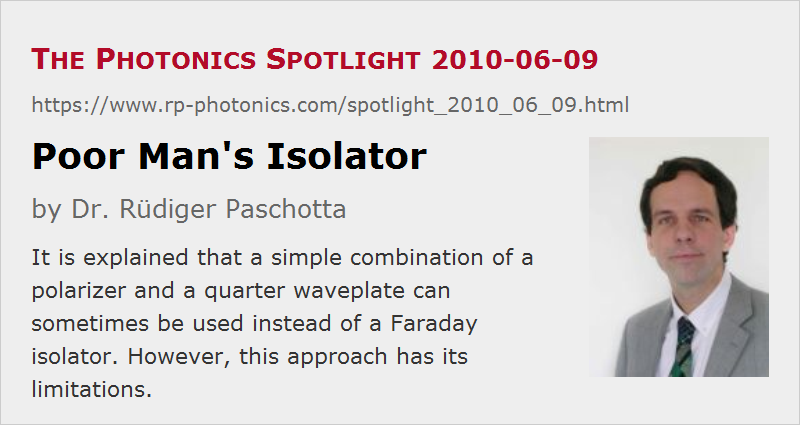Poor Man's Isolator
Posted on 2010-06-09 as a part of the Photonics Spotlight (available as e-mail newsletter!)
Permanent link: https://www.rp-photonics.com/spotlight_2010_06_09.html
Author: Dr. Rüdiger Paschotta, RP Photonics Consulting GmbH
Abstract: It is explained that a simple combination of a polarizer and a quarter waveplate can sometimes be used instead of a Faraday isolator. However, this approach has its limitations.
Ref.: encyclopedia articles on Faraday isolators and waveplates

Sometimes we need an optical isolator for suppressing back reflections from a device which might, e.g., disturb a laser source. Mostly, Faraday isolators are used for this purpose. But there is a simple substitute, which will do the job in some cases:
Send the beam through a polarizer first, then through a λ/4 waveplate, with the waveplate's axis being oriented at 45° against the polarization direction. Any light reflected back after the waveplate will do a double pass through it, so that it effectively sees a λ/2 plate. Its polarization direction is rotated by 90°, so that it will be blocked by the polarizer and thus cannot get back to the laser source.
Does This Replace a Faraday Isolator?
Unfortunately, we cannot always use that configuration instead of a much more expensive and bulky Faraday isolator:
- The light at the output of this device is circularly polarized. This is not ideal or even not usable in some situations; many optical setups are designed to work with linearly polarized light. In case that you try to be very clever and fix this with another λ/4 plate: that won't work, because the back-reflected light will no longer be blocked by the polarizer.
- In general, you should avoid any changes of polarization of back-reflected light. This can be hard to do, e.g. when you have any birefringent parts in your optical setup, or just with optical components hit with non-normal incidence.
The use of a Faraday isolator is more flexible: it delivers linearly polarized light to the application, and it can block back-reflected light with whatever polarization state.
Combining Both Methods
There is a way to combine both methods: just place a λ/4 waveplate after a Faraday isolator, again with 45° of its axis against the polarization direction. Assuming that the polarization state of the back-reflected light has not been changed, the waveplate will transform that into linearly polarized light such that the light cannot pass even the output polarizer of the isolator. Normally, it would get through this and be blocked only by the input polarizer. The degree of isolation possible with that setup can be substantially higher than with a Faraday isolator alone. But of course this works only when your setup can work with circularly polarized light and does not change the polarization of back-reflected light.
This article is a posting of the Photonics Spotlight, authored by Dr. Rüdiger Paschotta. You may link to this page and cite it, because its location is permanent. See also the RP Photonics Encyclopedia.
Note that you can also receive the articles in the form of a newsletter or with an RSS feed.
Questions and Comments from Users
Here you can submit questions and comments. As far as they get accepted by the author, they will appear above this paragraph together with the author’s answer. The author will decide on acceptance based on certain criteria. Essentially, the issue must be of sufficiently broad interest.
Please do not enter personal data here; we would otherwise delete it soon. (See also our privacy declaration.) If you wish to receive personal feedback or consultancy from the author, please contact him e.g. via e-mail.
By submitting the information, you give your consent to the potential publication of your inputs on our website according to our rules. (If you later retract your consent, we will delete those inputs.) As your inputs are first reviewed by the author, they may be published with some delay.
 |





If you like this page, please share the link with your friends and colleagues, e.g. via social media:
These sharing buttons are implemented in a privacy-friendly way!